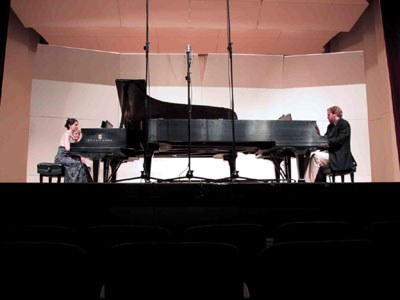
Michael Hawley
Mary Farbood
music for two pianos: live
recordings and notes
van cliburn amateur competition
fort worth, texas
june, 2000
Photograph by Viktors Berstis. See his online album from VC2000.
Franz
Liszt, around the time he wrote
Liszt's son-in-law, Richard Wagner.
In May of 2000, waking up like Rip van Winkle on internet time, I snapped myself out of a fit of abulia that had plagued me for the better part of a decade and suddenly remembered that I needed to learn about an hour of solo piano music for the Van Cliburn piano competition, to be held in Fort Worth in June. The stack of scores I had foolishly chosen to memorize was thicker than a dissertation on Chinese history. It would take a year to learn: I had only a few weeks!
Jumping at the chance to procrastinate, I eagerly set the pile aside and turned my attention instead toward a concert of two piano music with Mary Farbood, chiefly consisting of obscenely large orchestral works by Liszt and Wagner that had been rearranged, somehow, for two pianos. After digesting all of that, there was surely no possible way I would be able to learn my solo repertoire in time, except perhaps on the plane ride to Dallas-Fort Worth. Thus satisfied that this Augean task, this "Symphonic Prologue to a Tragedy" as the imitable Max Reger might have called it, was sure to derail my quest for the solo piano amateur gold, I plunged into the two piano repertoire with gay abandon.
Mary had learned of some Wagner operatic overtures that had been arranged in a peculiar way for two pianos by none other than Max Reger. So she contacted Frau Blucher at the Maxregerinstitutevonkarlsruhe, who still had a few of the scores handy (paper towels are in short supply at the Institute in Karlsruhe). We thought it would be amusing to use this music to reduce a couple of large and expensive pianos to smithereens. And, veni, vidi, vinci, we did. The concert was announced to a small but dwindling group of admirers. Tickets rapidly sold out, and the overflow audience of four or five MIT sophomores all agreed that they had gone to the wrong classroom.
But having had the effrontery to regale the local degenerates in this way, we still were not content. And so, stuffing Mary into a carry-on bag, I flew to Texas, reconnected with my 300-pound Samoan attorney, and aimed the rented Buick with its overinflated tires for the Texas Christian University where the amateur competition was already underway. As the last chord in Chopin's g minor ballade faded for the seventeenth time that afternoon, I bowled on into the concert hall.
I was chagrined to see only one Steinway concert grand on stage. Sensing a lull, I asked Richard Rodzinski about the appalling dearth of pianos. He whispered to me that there was a second Steinway concert grand handy just in case one of the performers mistook the first one for a Baldwin and started chopping at it with a proverbial red-handled fire axe. That was all the encouragement we needed. Bursting out of my carry-on bag, Mary leapt onto the stage and shoved the pianos into position. There was no need to rehearse. Richard popped the lid off the front piano and, tossing it into the audience like a foul tip into the stands at Yankee stadium, he thrilled the audience by announcing that Mary and I would now play "duelling banjos" on the two Steinways, followed by duelling g minor ballades as an encore. That stirred up a good deal of public apathy.
Enjoying the thick sleep that follows an orgy, audio engineer Jim Jackson had forgotten to push the stop button on his recording machine. Someone had the consideration to let him remain in his stupor. And that is how this unique recording was produced.
Program notes from the June 1, 2000 MIT concert are here.
Michael
Hawley
|